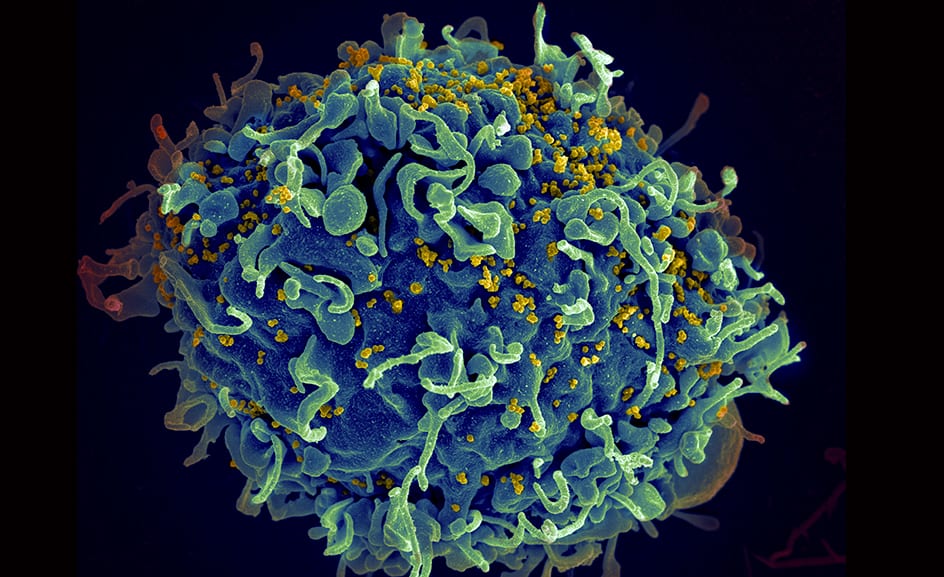
This electron microscope image made available by the U.S. National Institutes of Health shows a human T cell, in blue, under attack by HIV, in yellow, the virus that causes AIDS. (Associated Press)
A study of gay couples published Thursday, May 2, in the medical journal Lancet indicates that HIV-positive men in whom the infection is fully suppressed by anti-retroviral drugs have no chance of passing the virus to their partner, even through sex without a condom.
The Guardian newspaper reported on the findings with the headline declaring “End to AIDS in sight,” and noting, “The success of the medicine means that if everyone with HIV were fully treated, there would be no further infections.” Earlier studies, the Guardian report noted, have shown that the drugs also stop transmission in straight couples where one partner is HIV-positive and the other is negative.
According to the paper in the Lancet, 972 sero-discordant gay couples were enrolled in the study from September 2010 to July 2017, and the HIV-positive partner was receiving treatment to suppress the virus, there were no cases in which the HIV-negative partner was infected through condomless sex with his partner.
There were 15 men who contracted HIV during the study, but DNA testing proved they were infected through sex with someone other than their partner.
Professor Alison Rodger with University College London, co-leader of the paper published in the Lancet, called the results “brilliant — fantastic,” telling The Guardian that the study “very much puts this issue to bed. … Our findings provide conclusive evidence for gay men that the risk of HIV transmission with suppressive [antiretroviral therapy] is zero. Our findings support the message of the international U=U campaign that an undetectable viral load makes HIV untransmittable.”
Rodger added, “This powerful message can help end the HIV pandemic by preventing HIV transmission.” She urged increased focus on “wider dissemination” of the U=U message and on ” ensuring that all HIV-positive people have access to testing, effective treatment, adherence support and linkage to care to help maintain an undetectable viral load.”
According to the Centers for Disease Control, at the end of 2016, 1.1 million people aged 13 and older had HIV infection in the United States, including an estimated 162,500 people — 14 percent — whose infections had not been diagnosed. And in 2017, the number of new HIV diagnoses in the United States and its six dependent areas was 38,739. A CDC Fact Sheet published in August 2016 indicated that only 36 percent of those infected were accessing treatment.
Globally, there were approximately 36.9 million people worldwide living with HIV/AIDS in 2017, according to HIV.gov, a U.S. government website created to “expand the visibility of timely and relevant federal HIV policies, programs, and resources to the American public.” Of those nearly 37 million people, only about 75 percent were aware of their HIV-positive status. The remaining 25 percent ” still need access to HIV testing services. HIV testing is an essential gateway to HIV prevention, treatment, care and support services,” the website said. Only 59 percent of those infected with HIV in 2017 were accessing anti-retroviral therapy,












